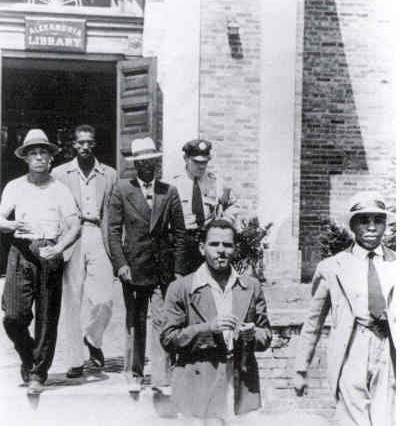The Alexandria Library sit-in was one of the first acts of civil disobedience of its type in United States history involving racial discrimination and is credited with pioneering the use of nonviolent direct action. The sit-in occurred at the racially segregated Alexandria Public Library in Alexandria, Virginia, on August 21, 1939, and was an early model for sit-ins that would occur in the 1950s and 1960s.
The Alexandria Public Library was built in 1937 from money donated by the Kate Waller Barrett family. Although its operation was supported by the city’s Black and white taxpayers, only whites could use the facility. Samuel Wilbert Tucker, a Black Howard University graduate and attorney, devised a strategy to challenge the library’s exclusion policy. He asked his friend, retired army sergeant George Wilson, to apply for a library card.
On March 17, 1939, Wilson went to the Alexandria Public Library, completed his application for a library card, and asked the librarian to issue the card. When the librarian refused, Tucker initiated a lawsuit on behalf of Wilson’s right to access the library. He argued that Wilson’s rights had been violated. Tucker recognized that the Virginia Public Assemblages Act of 1926 called for the segregation of Blacks and whites in public accommodations, but it did not bar African Americans from those accommodations. During the summer of 1939, Tucker also began training a group of African American men for nonviolent protest at the library. The eight young Black men he selected ranged in age from 18 to 22.
On August 21, 1939, five men, William Evans, Otto L. Tucker, Edward Gaddis, Morris Murray, and Clarence Strange, went to the library. The three other men scheduled to participate in the protest were kept home by their parents, who feared for their safety. As the five young men entered the Alexandria Library, one approached Liberian Katherine A. Scoggins for a library card. Scoggins explained that library policy barred her from issuing cards to Black people. After each man was refused a card, they picked a book from the shelf, sat at a library table, and began to read silently. Scoggins ran to city hall, where she informed the city manager about the five protestors at the library. He then called the Alexandria police. As the police arrived to arrest the men and escort them out of the library, they encountered 300 onlookers, including reporters and photographers from the Washington Post, Washington Times, Washington Tribune, and The Baltimore Afro-American.
The five men were charged with disorderly conduct. Tucker defended them in court. The judge did not issue a ruling, and as a result, the five did not have to serve time in jail. In response to this incident, the Alexandria Library Board approved the construction of the Robert H. Robinson Library, a segregated facility for use only by the city’s Black population. Alexandria’s African Americans continued to use the facility until the 1964 Civil Rights Act desegregated all the city’s libraries.
In 1999, a documentary movie, Out of Obscurity: The Story of the 1939 Alexandria Library Sit-In, was released. On October 18, 2019, the Alexandria Circuit Court finally dismissed all charges against the sit-in participants.

